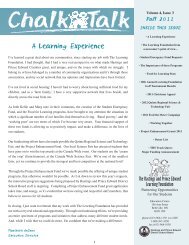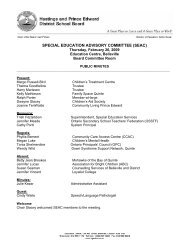Grade 11 Healthy Active Living Education Additional Supports ...
Grade 11 Healthy Active Living Education Additional Supports ...
Grade 11 Healthy Active Living Education Additional Supports ...
You also want an ePaper? Increase the reach of your titles
YUMPU automatically turns print PDFs into web optimized ePapers that Google loves.
Policy/Law Impact on Health<br />
Smoking by-law:<br />
• Many cities in North America have begun<br />
placing restrictions where individuals can<br />
smoke in public places to protect the public<br />
from being exposed to environmental<br />
tobacco smoke.<br />
For example, since June 1, 2001 TorontoÕs<br />
by-law prohibits smoking in public such as<br />
restaurants and dinner theatres unless it is<br />
done in an approved fully enclosed and<br />
separately ventilated designated smoking<br />
room that is not greater than 25% of<br />
occupiable space. See local city website to<br />
review local smoking by-laws.<br />
Tobacco Control Act:<br />
• Has been in effect in Ontario since 1994.<br />
• Municipalities, provincial governments and<br />
federal governments have laws relating to<br />
tobacco control.<br />
• The legal age to buy tobacco is 19 years<br />
old and acceptable forms of ID to show<br />
when purchasing tobacco include: Ontario<br />
drivers license, Canadian passport,<br />
Canadian citizenship card, age of majority.<br />
• It is illegal to buy or sell tobacco to minors.<br />
• Smoking is banned in schools and on<br />
school property.<br />
Legal Drinking Age:<br />
• Addressed under the Liquor License Act.<br />
• Provincial Statue 19 years old in Ontario.<br />
• By-laws of this kind have been successful<br />
in limiting the publicÕs exposure to<br />
environmental tobacco smoke in other<br />
regions where they have been implemented<br />
for several years as well as denormalizing<br />
smoking behaviour.<br />
• Limiting access of youth to tobacco is one<br />
element of a successful program aimed at<br />
reducing the rate of smoking.<br />
• ÒResearch has shown that enforcing the<br />
law restricting sales to minors and/or<br />
providing education can reduce the number<br />
of over the counter sales, and possibly the<br />
rate of smoking among young peopleÓ<br />
(Centre for Addiction and Mental Health,<br />
1999).<br />
• Youth get addicted to smoking if they can<br />
get cigarettes easily.<br />
• If youth have not started smoking by age<br />
20, there is less chance that they will not<br />
smoke at all.<br />
• The younger a person begins smoking, the<br />
greater the risk for developing the<br />
numerous illnesses and characteristics<br />
associated to smoking (e.g., decrease in<br />
physical fitness, early development of<br />
artery disease, a possible precursor to heart<br />
problems).<br />
• Raising the legal drinking age has been has<br />
been a factor in reducing the drinking and<br />
driving rates among youth (Centre for<br />
Addiction and Mental Health, 1999).<br />
<strong>Grade</strong> <strong>11</strong> <strong>Healthy</strong> <strong>Active</strong> <strong>Living</strong> <strong>Education</strong> (PPL30), Module #3 Violence and Risk Taking Behaviour<br />
Page 64
















